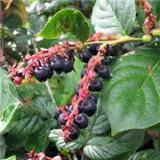Hi Friends! Ahhh, summertime! Ahhh, swimming! Ahhh, wild berries! My most favorite being the very small, very underrated, very sweet Native Trailing Blackberry, or Rubus ursinus. You'll find this crawling shrub in most forests around B.C and down to California and as far east as Montana.
They grow best in disturbed areas where logging (boo!) ect. has gone on. I am sure that you have seen or even tasted the more common introduced species of blackberries, the Himalayan and/or the Evergreen blackberry that grow along roadsides and backyards. The less common Rubus ursinus has superior flavor and less prickly vines than the other two. First Nations Peoples picked these berries and dried them in to cakes.
They also used the leaves in tea to cure bouts of dysentery, bonus! So, when you're walking down the trail in a few weeks, (they are usually out from the end of July to Mid September, depending on the type of summer) keep your eyes open under the brush.
If you see any without berries or flowers, it is likely a male shrub as this species are dioecious, meaning there are both male and female plants. Pretty neat!!! Good luck, keep up the good work, put some of these berries on your cereal when you wake up to watch the sunrise!



